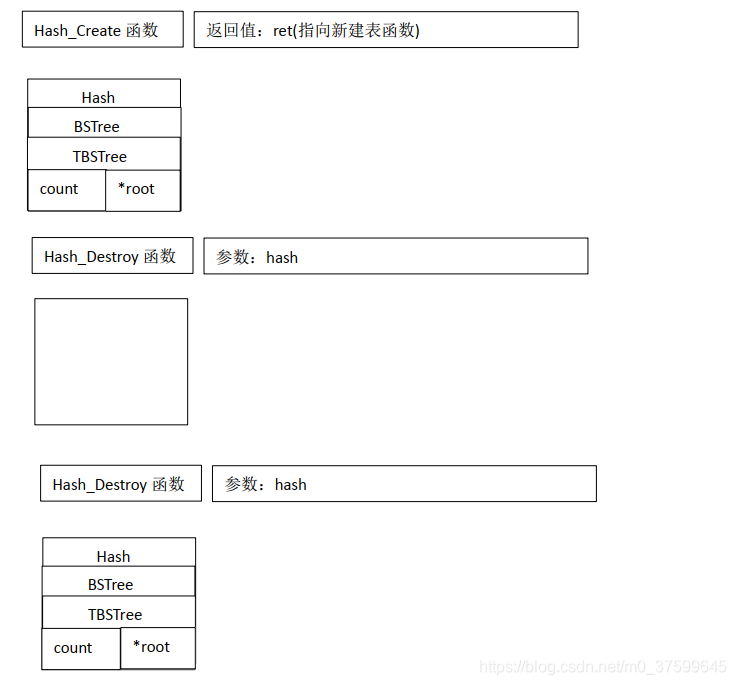目录:
- 代码:
- 分析:
代码:
BSTree.h
BSTree.c
二叉排序树(Binary Sort Tree) 又称为二叉查找树(Binary Search Tree)
Hash.h
#ifndef _HASH_H_
#define _HASH_H_typedef void Hash;//定义哈希表类型
typedef void HashKey;//定义哈希表键类型
typedef void HashValue;//定义定义哈希表值类型typedef int (Hash_Compare)(HashKey*, HashKey*);//定义参数为两个哈希表键类型指针返回值是整形的函数类型Hash* Hash_Create();//声明创建哈希表函数
void Hash_Destroy(Hash* hash);//声明销毁哈希表函数
void Hash_Clear(Hash* hash);//声明清空哈希表函数
int Hash_Add(Hash* hash, HashKey* key, HashValue* value, Hash_Compare* compare);//声明添加值函数
HashValue* Hash_Remove (Hash* hash, HashKey* key, Hash_Compare* compare);//声明移除值函数
HashValue* Hash_Get(Hash* hash, HashKey* key, Hash_Compare* compare);//声明获取值函数
int Hash_Count(Hash* hash);//声明获取数量函数#endifHash.c
#include <stdio.h>
#include <malloc.h>
#include "Hash.h"
#include "BSTree.h"typedef struct _tag_HashNode HashNode;//定义哈希表节点类型
struct _tag_HashNode
{BSTreeNode header;HashValue* value;
};
//定义递归释放节点函数
void recursive_clear(BSTreeNode* node)
{if( node != NULL ){recursive_clear(node->left);recursive_clear(node->right);free(node);}
}Hash* Hash_Create()//定义创建哈希表函数
{return BSTree_Create();//创建一个树
}void Hash_Destroy(Hash* hash)//定义销毁哈希表函数
{Hash_Clear(hash);//清空哈希表BSTree_Destroy(hash);//再销毁树
}void Hash_Clear(Hash* hash)//定义清空哈希表函数
{//先清除释放节点的空间。这释放的其实是HashNode类型的空间//是在Hash_Add新建的node节点,因为转换类型成树的节点,但还是那块内存开头//所以会释放HashNode中的Value.recursive_clear(BSTree_Root(hash));BSTree_Clear(hash);//再将树清空重置
}
//定义添加值函数
int Hash_Add(Hash* hash, HashKey* key, HashValue* value, Hash_Compare* compare)
{int ret = 0;HashNode* node = (HashNode*)malloc(sizeof(HashNode));//新建节点if( ret = (node != NULL) )//创建成功{node->header.key = key;//将新建的键赋给树点的键node->value = value;//将新建的值赋给哈希节点的值ret = BSTree_Insert(hash, (BSTreeNode*)node, compare);//将哈希转换插入到树if( !ret )//如果不成功释放新建节点{free(node);}}return ret;
}
//定义移除值函数
HashValue* Hash_Remove(Hash* hash, HashKey* key, Hash_Compare* compare)
{HashValue* ret = NULL;HashNode* node = (HashNode*)BSTree_Delete(hash, key, compare);//从树中删除节点,并返回删除节点if( node != NULL )//如果有该节点{ret = node->value;//取得节点内的值free(node);//释放该节点}return ret;//返回值
}
//定义获取值函数
HashValue* Hash_Get(Hash* hash, HashKey* key, Hash_Compare* compare)
{HashValue* ret = NULL;HashNode* node = (HashNode*)BSTree_Get(hash, key, compare);//从树中获取节点if( node != NULL )//如果有该节点{ret = node->value;//取得值}return ret;//返回值
}int Hash_Count(Hash* hash)//定义获取数量函数
{return BSTree_Count(hash);
}main.c
#include <stdio.h>
#include <stdlib.h>
#include "Hash.h"struct Student
{char* id;char* name;int age;
};int compare_id(HashKey* k1, HashKey* k2)//比较字符串
{return strcmp((char*)k1, (char*)k2);
}int main(int argc, char *argv[])
{Hash* hash = Hash_Create();struct Student s1 = {"9001201", "Delphi", 30};struct Student s2 = {"0xABCDE", "Java", 20};struct Student s3 = {"koabc", "C++", 40};struct Student s4 = {"!@#$%^", "C#", 10};struct Student s5 = {"Python", "Python", 10};struct Student* ps = NULL;Hash_Add(hash, s1.id, &s1, compare_id);Hash_Add(hash, s2.id, &s2, compare_id);Hash_Add(hash, s3.id, &s3, compare_id);Hash_Add(hash, s4.id, &s4, compare_id);Hash_Add(hash, s5.id, &s5, compare_id);ps = Hash_Get(hash, "koabc", compare_id);printf("ID: %s\n", ps->id);printf("Name: %s\n", ps->name);printf("Age: %d\n", ps->age);Hash_Destroy(hash);return 0;
}分析:







方法与示例)



——常用操作)


方法与示例)

输出pcm文件)
)

方法与示例)

)

输出yuv420p文件)
)
随机产生两个1~10的正整数,在屏幕上输出题目,如:5+3=?(2)学生输入答案,程序检查学生输入答案是否正确,若正确,)